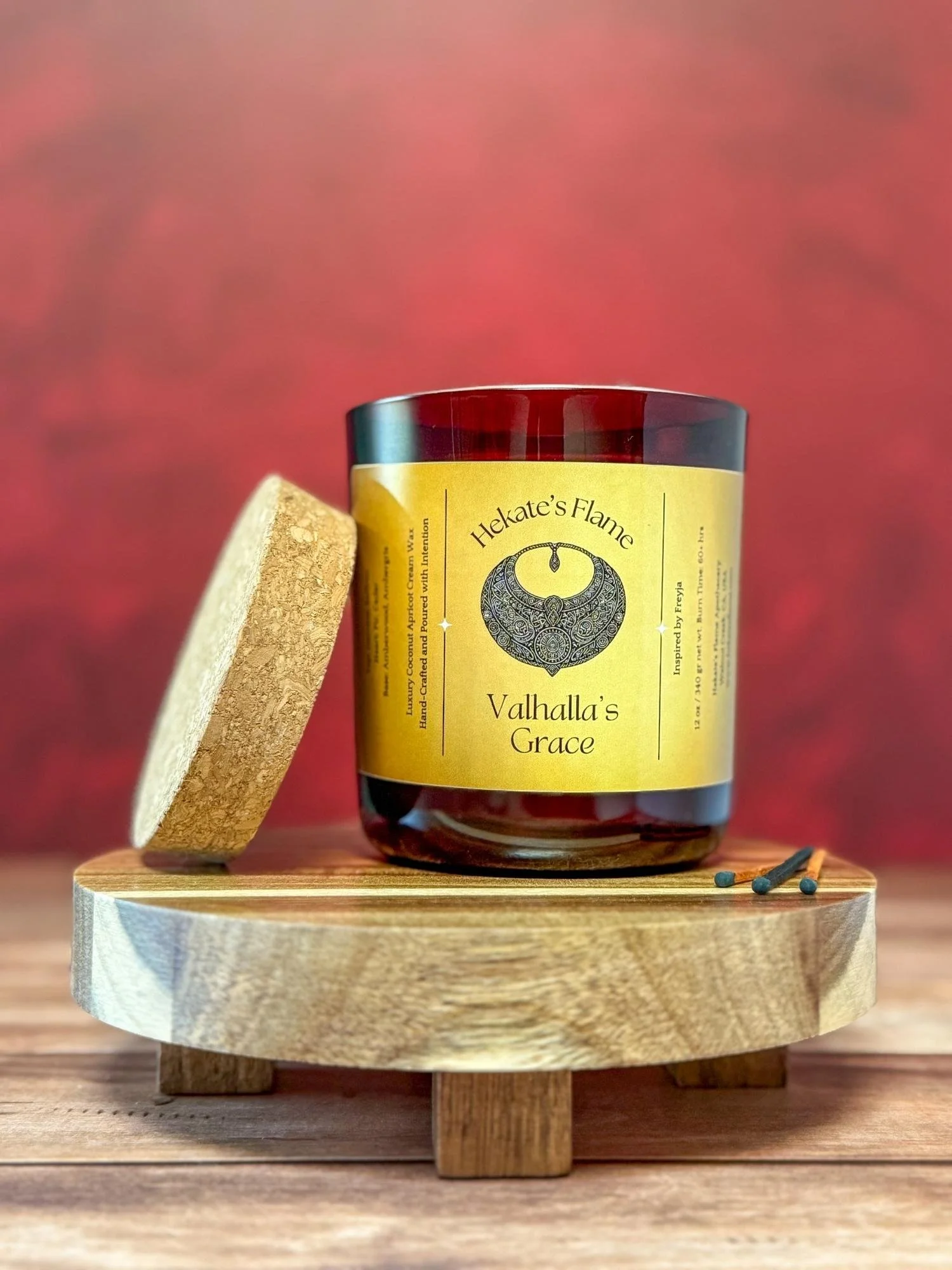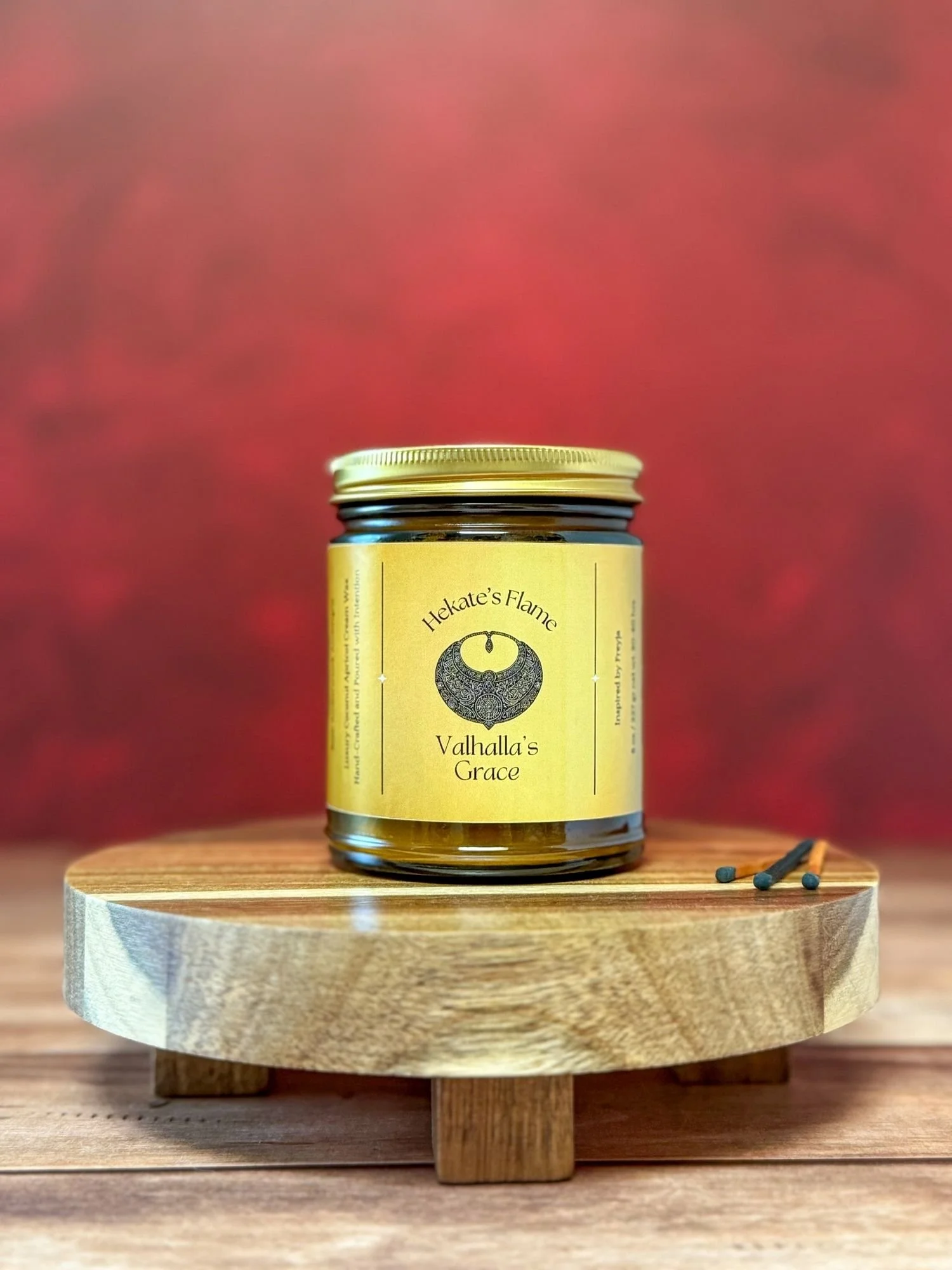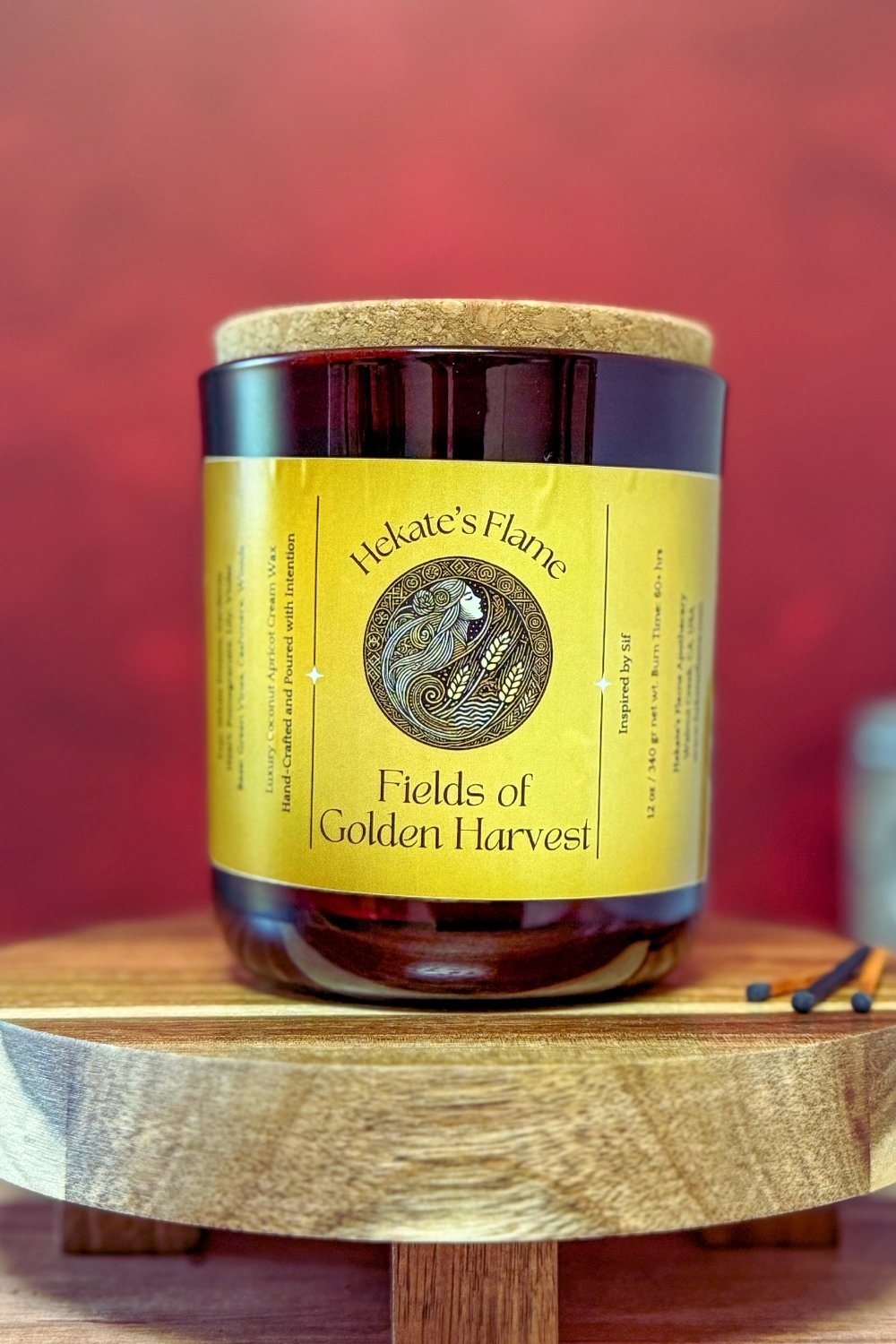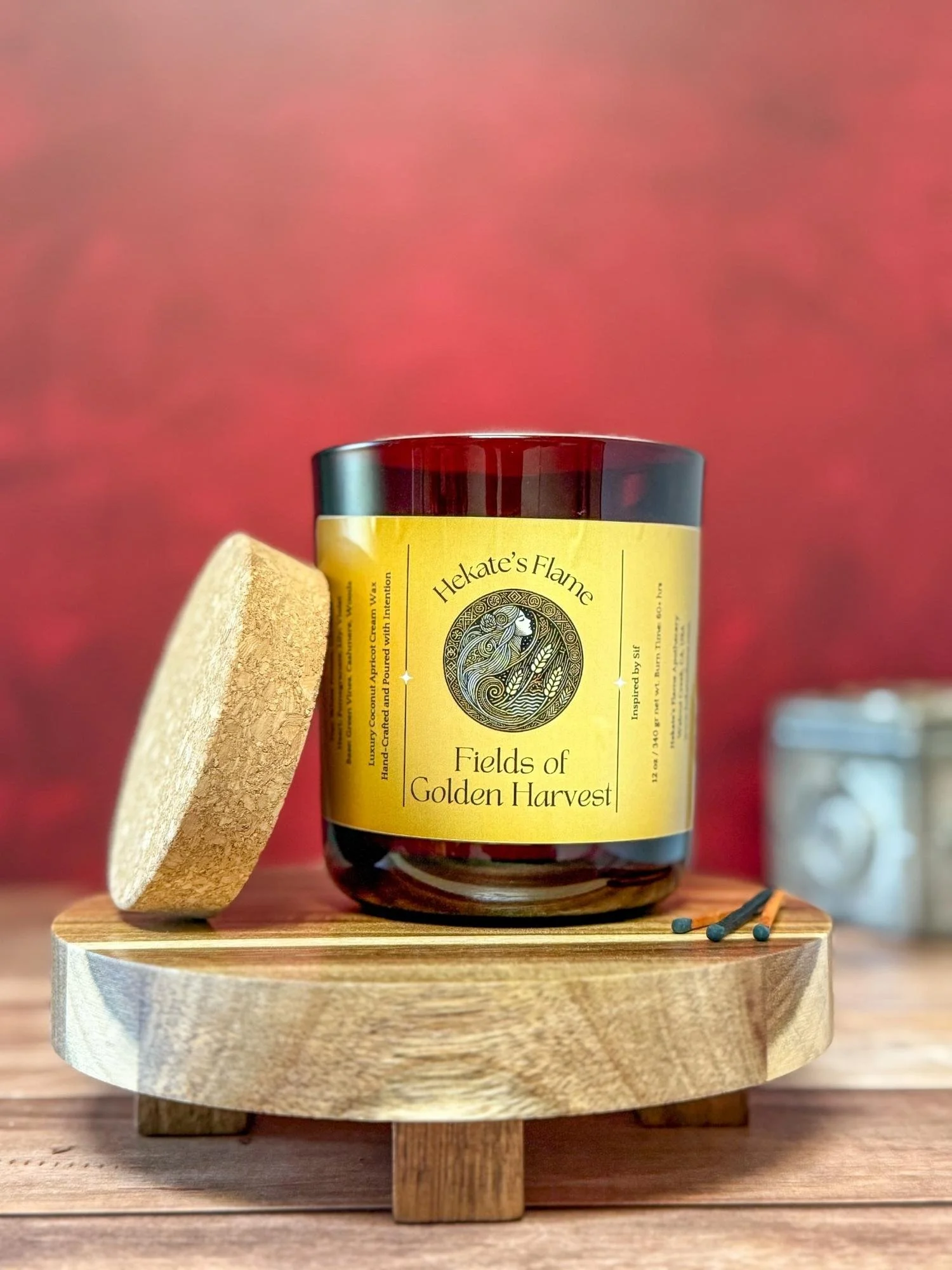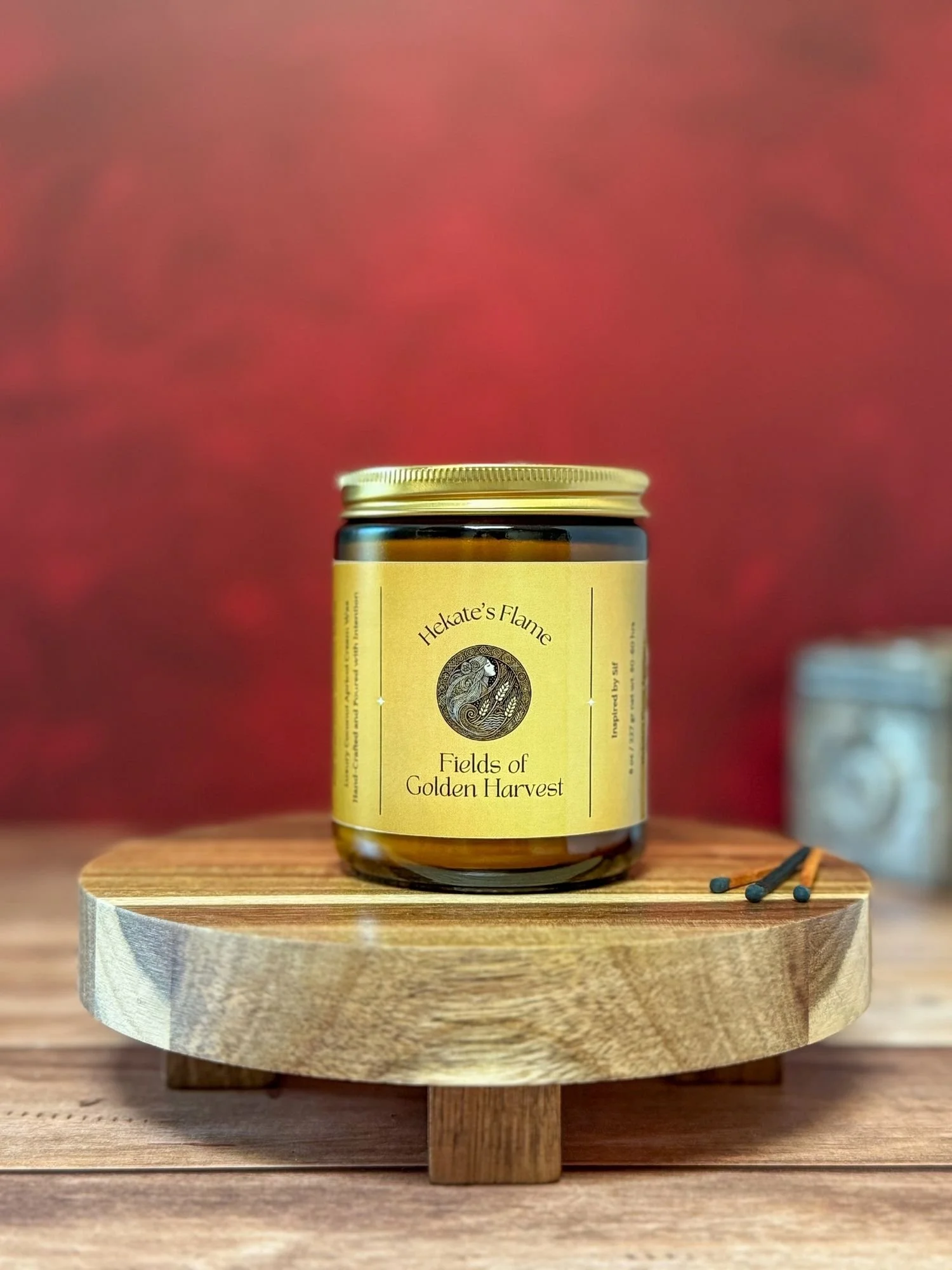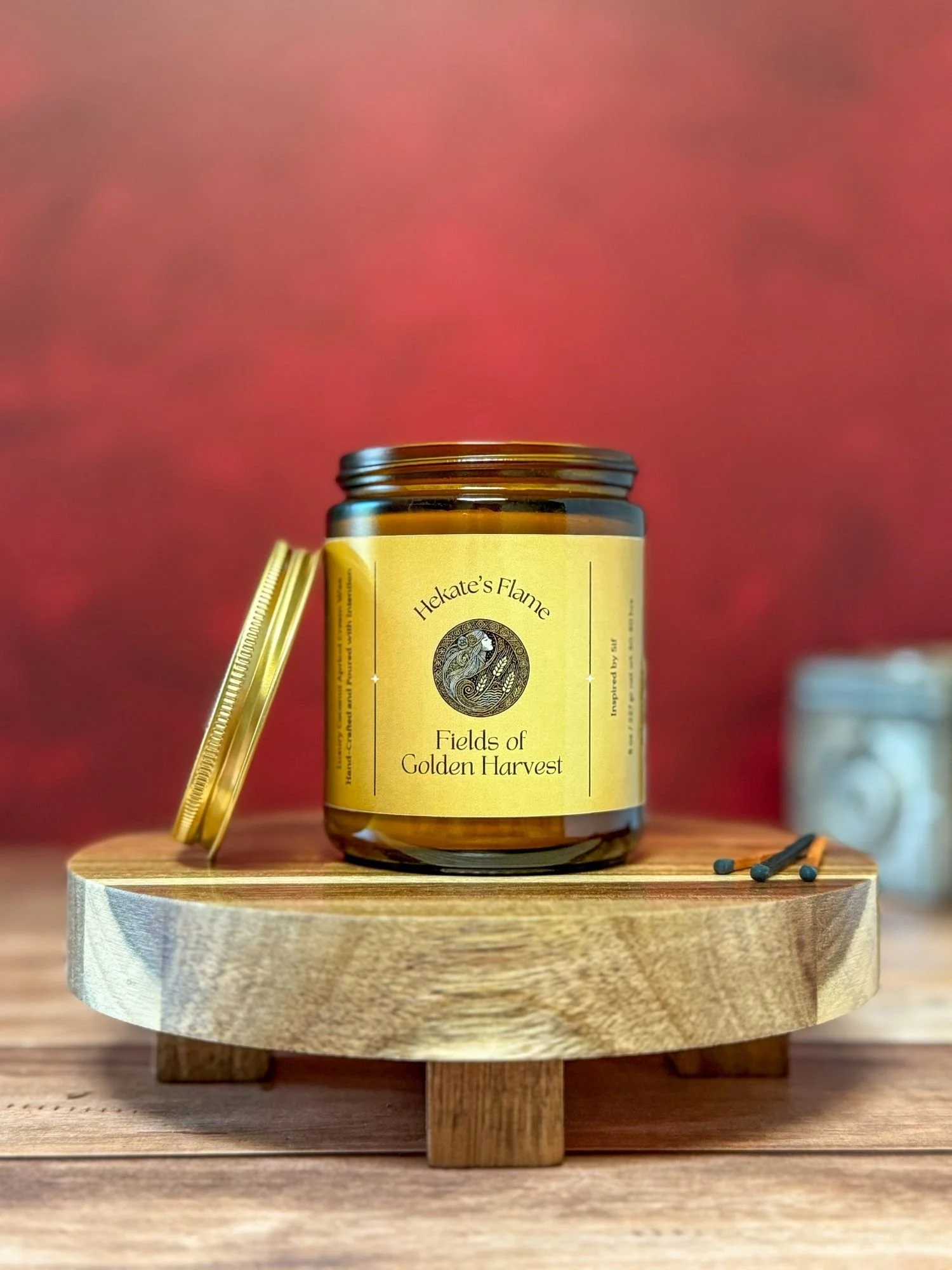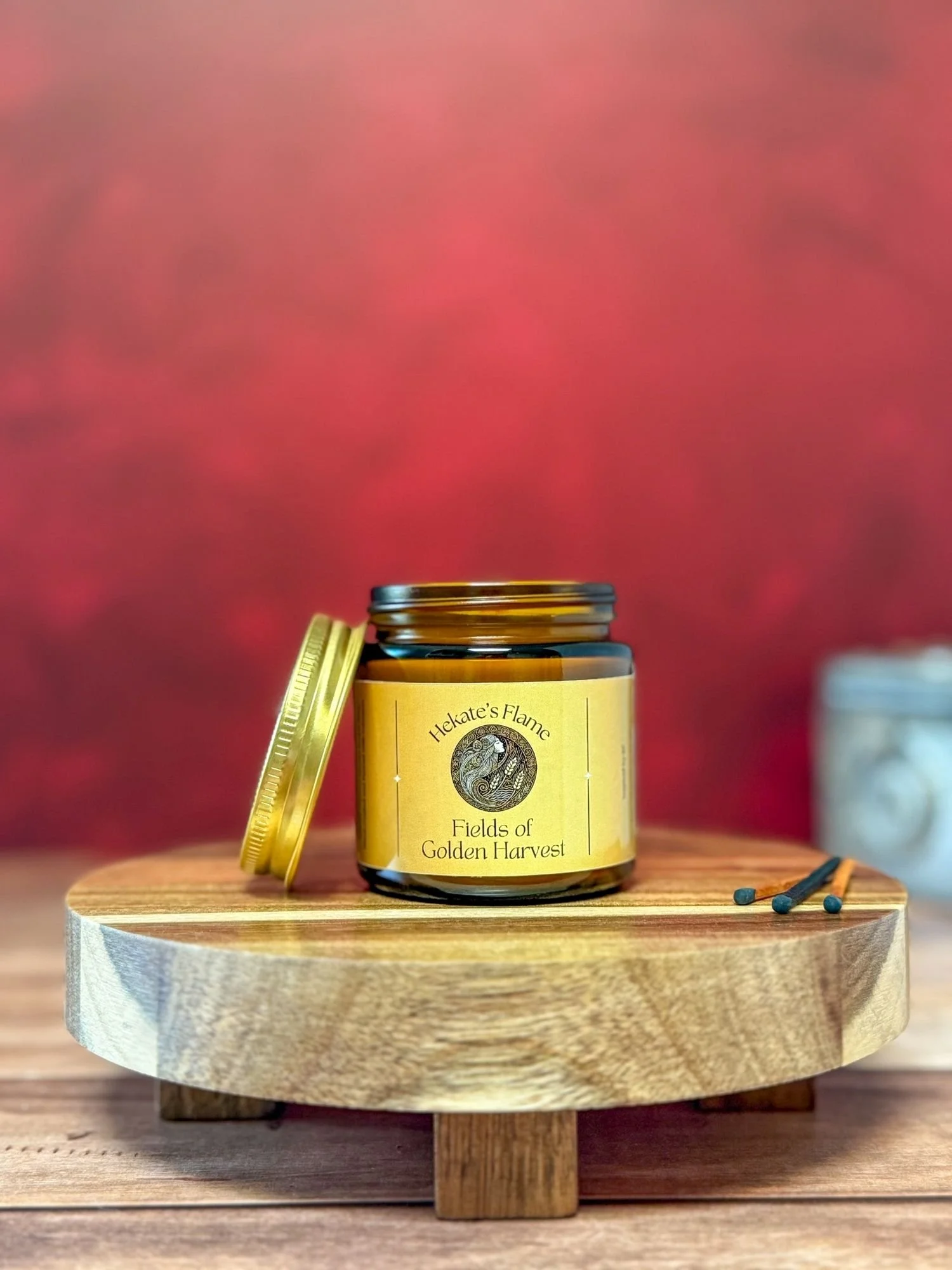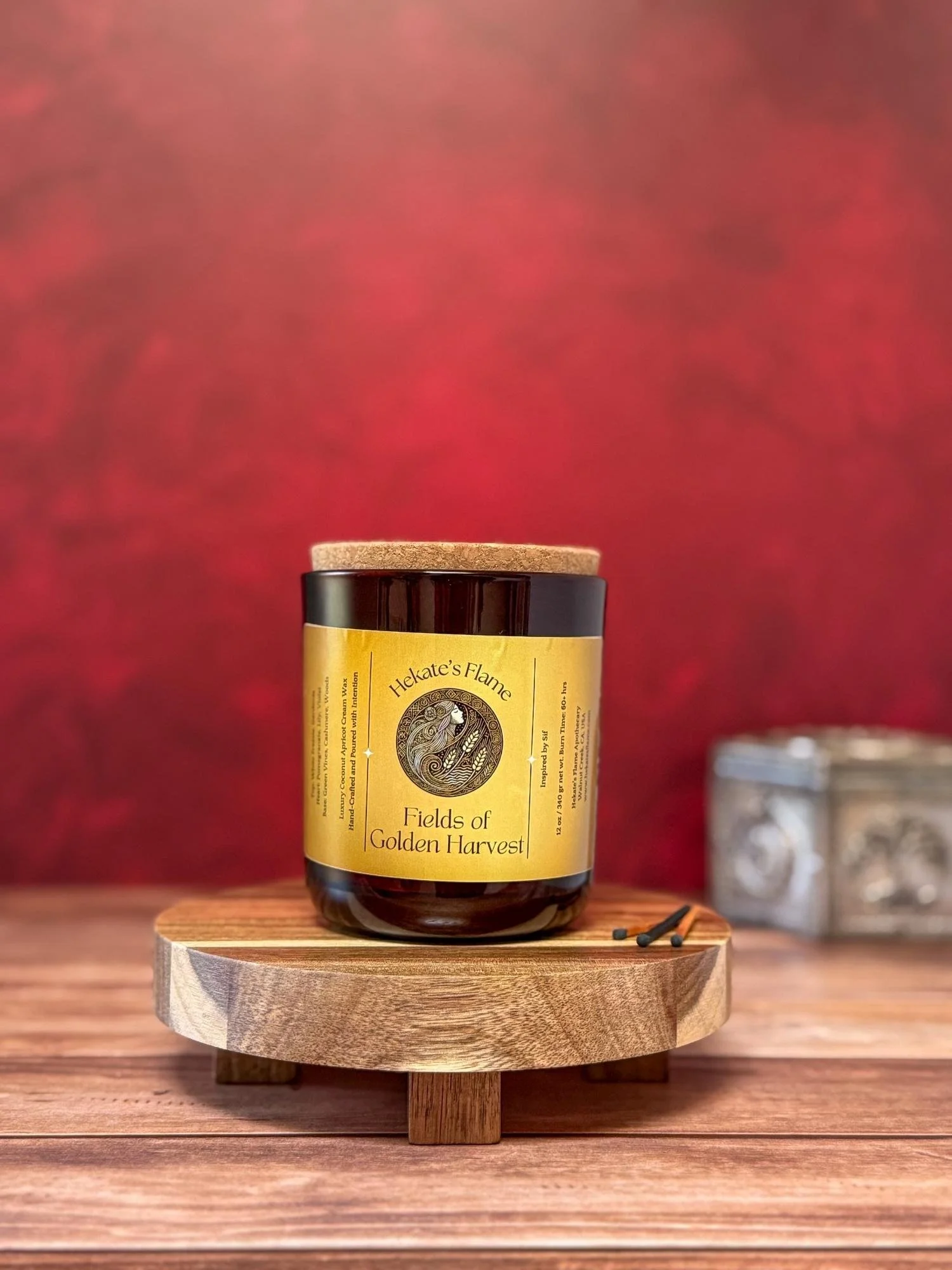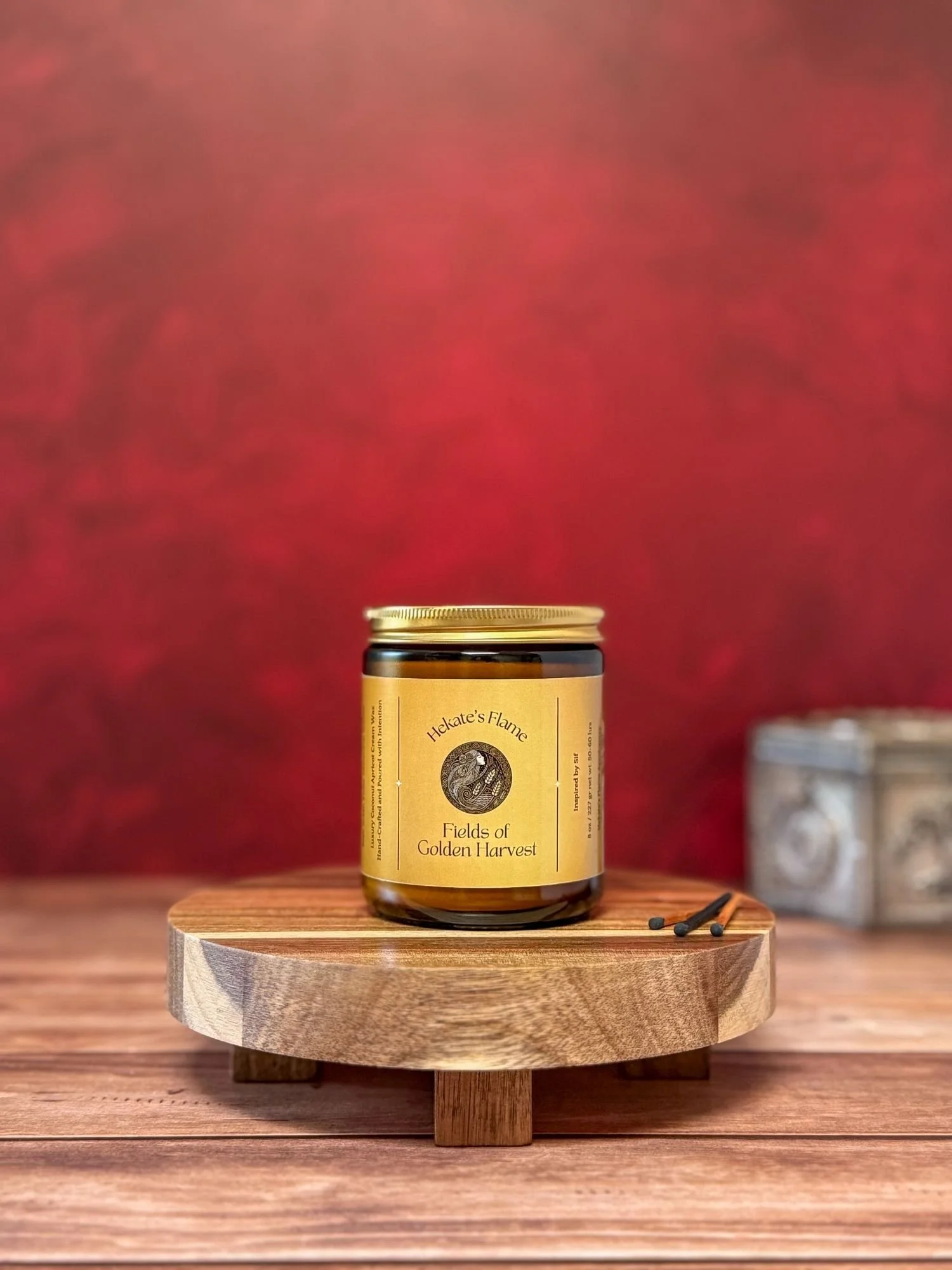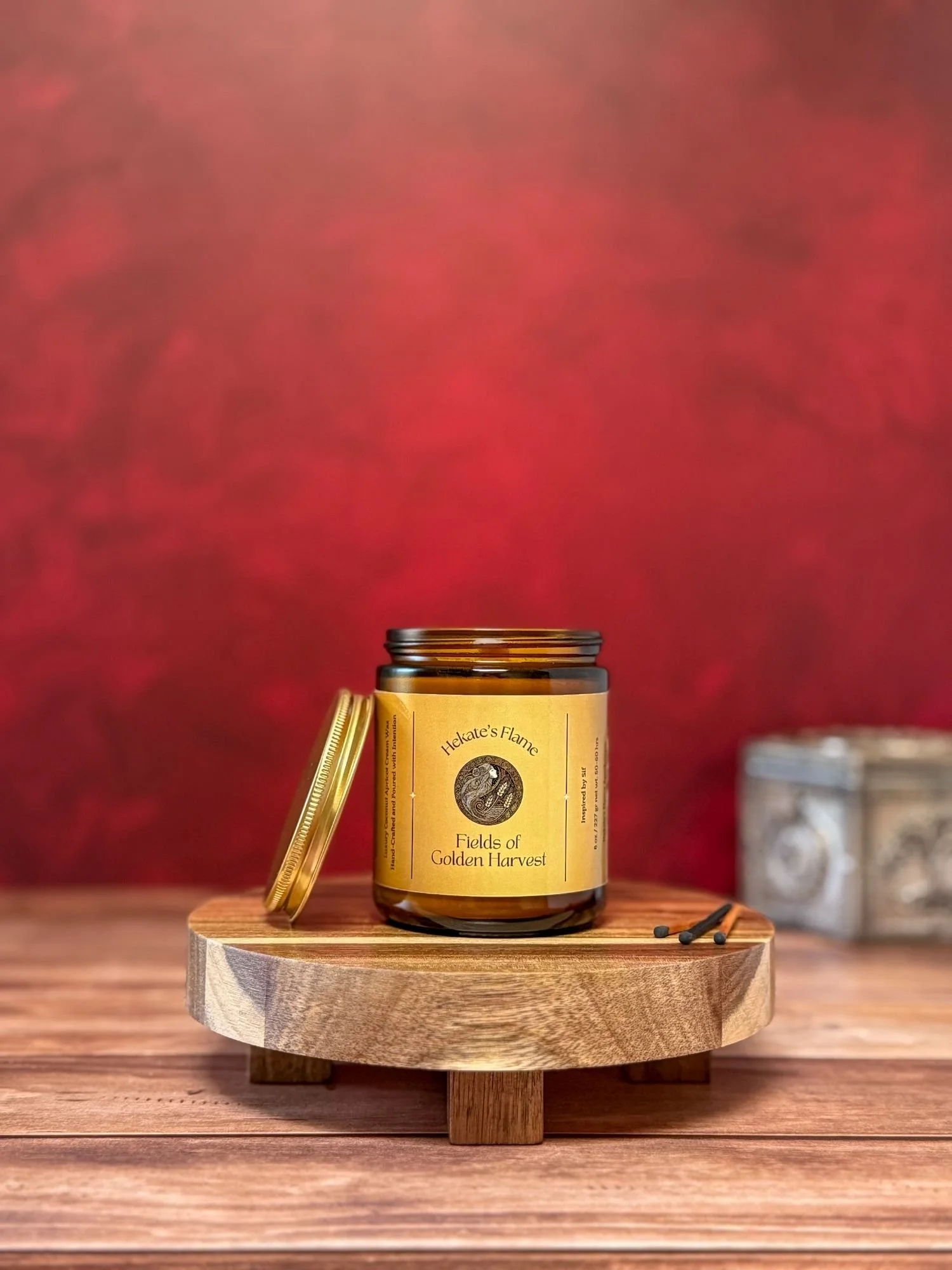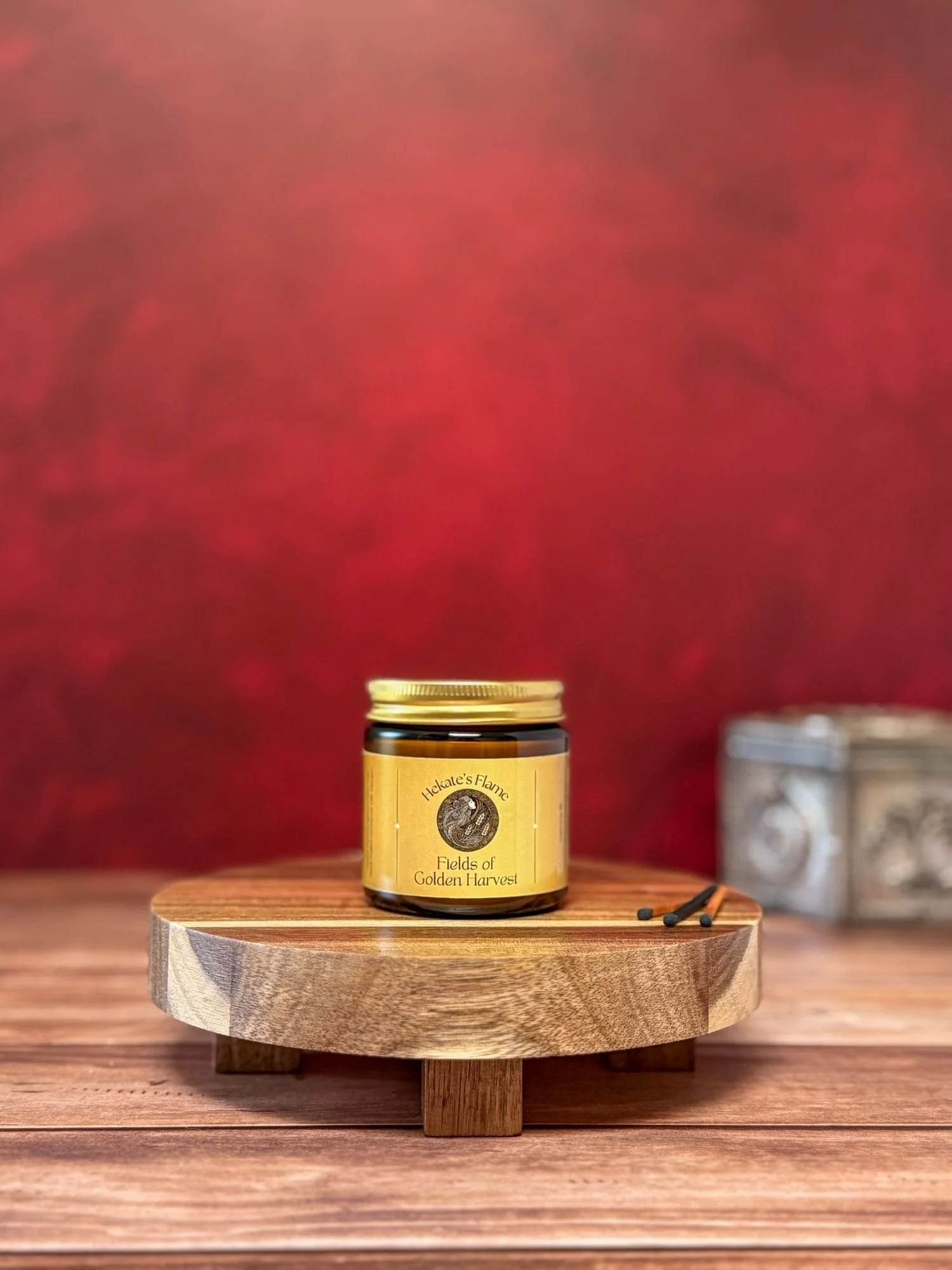‘Valkyries’ Vigil’: a handmade artisanal candle inspired by the Valkyries, the Norse warrior women who guide the fallen to Odin’s hall of the slain, Valhalla
They who ride the stormwinds and carry the fallen to halls of honor.
Imagine storm clouds gathering over an endless plain, wind singing with prophecy and power. That is the spirit of Valkyries’ Vigil: mint, ozone, and camphor sharp as cold air before thunder, eucalyptus, peppermint, cypress, and sage rising like breath in the frost, and patchouli, juniper, and cedar burning with solemn warmth. A scent of valor and reverence, honoring the Valkyries who ride the stormwinds and bear the chosen home.
Scent Notes:
Top: Mint, Ozone, Camphor
Heart: Eucalyptus, Peppermint, Cypress, Sage
Base: Patchouli, Juniper, Cedar, Spice, Incense
❄️ Season Scent: Winter
🌿 Primary Scent Family: Aromatic & Herbal
🌲 Secondary Scent Family: Woody & Earthy
Please visit this blog post for more information on Scent Profiles, Top, Heart, and Base Notes.
Our candles are lovingly handcrafted in our home studio, Nimue’s Lair, nestled in Walnut Creek, CA. Each one begins with a luxurious blend of coconut-apricot wax, carefully infused with premium fragrance oils. Poured by hand into elegant glass vessels and amber jars, they’re finished with hand-cut labels and enchanted final touches. Every candle is a small ritual, infused with magick, intention, and the quiet glow of story.
-
12 oz Deluxe – Wine Red Aura Glass · Coco Apricot Wax
Burn Time: 60+ hours
Bold and enduring, this candle fills your space with myth and memory. Crafted for spacious sanctuaries, this candle shines in wide-open living rooms, high-ceilinged studios, and sacred hearths ~ places where scent is free to roam and the flame becomes a luminous companion to stillness and story.8 oz Classic – Amber Jar · Coco Apricot Wax
Burn Time: 50–60 hours
A perfect size for quiet corners and thoughtful pauses. Let it warm your reading nook, home office, or bedside altar, where its flame flickers like a whisper of intention.4 oz Petite – Amber Jar · Coco Apricot Wax
Burn Time: 20–25 hours
Small in size, rich in presence. This candle is ideal for travel, gifting, or sanctifying intimate spaces - guest rooms, personal altars, or quiet corners where scent and flame are invited to linger with intention. -
For detailed information about our waxes, wicks, fragrance blends, and vessels, please see our Ingredients & Materials Guide.
-
For guidance on how to tend your flame with care, ensuring the cleanest, safest, and most enchanting burn, please visit our Candle Care Guide.
-
Please visit the Shipping and Returns Information page for details.
-
All photographs, images, and written content on this website are original works of Hekate's Torch Apothecary, LLC (doing business as Hekate’s Flame Apothecary) and are protected by copyright. They may not be used, altered, shared, or reposted on any platform without explicit written consent. All label designs, photos, images, and content are the exclusive property of Hekate's Torch Apothecary, LLC.
For inquiries regarding the use of our content, please contact: care@hekatesflame.com
© 2025 Hekate's Torch Apothecary, LLC. All rights reserved.
Content Warning:
This post explores ancient myths that include themes of violence, including assault and warfare, which may be sensitive for some readers. Please proceed with care and be mindful of your well-being while engaging with these stories.
Valkyries: Norse Choosers of the Slain
In the windswept verses of Norse sagas, amid the icy landscapes and battle-scarred plains, ride the Valkyries, formidable spirits of death and destiny, warriors astride ethereal horses, whose spectral wings slice through the mist like blades. Known as valkyrjur, or "choosers of the slain," these powerful female figures straddle the line between life and death, love and vengeance, blood and valor. Though often portrayed as noble escorts bearing slain heroes to Odin's hall, the Valkyries are more than mere attendants of the dead; they embody fate's cold hand, woven into the fabric of creation and destruction.
Origins of the Valkyries: Guardians of Fate and the Fallen
The word "Valkyrie" is a composite of the Old Norse valr (meaning "the slain") and kyrja (meaning "chooser"). This title speaks to their essential role: to decide who among warriors shall live and who shall die. As Odin's messengers, they drift across battlefields, invisible yet palpable, like a whisper of doom, a herald of death's inexorable approach. They serve the Allfather, Odin, and their role is interwoven with his own, much like Hugin and Munin, the ravens who fly across the earth gathering secrets. Yet the Valkyries represent more than messengers; in some stories, they embody aspects of Odin himself, reflecting fragments of his power and will. As shamanic spirits, they act almost as projections of his omnipotent reach, extensions of his godly essence flitting across the realms, imparting death's decree to mortal men.
Their very names reflect their powerful roles and purpose within Odin's sphere of influence. Each Valkyrie carries a title that resonates with her particular strength on the battlefield. Geiravör, the "Spear-Goddess," embodies the piercing force of a weapon aimed true; Herfjötur, meaning "War-Fetter," holds warriors captive in her battle-laden aura. Names like Skögul ("Shaker") and Randgríð ("Shield-Destroyer") convey a presence that strikes fear into foes, while Hildr ("Battle") personifies the clash and frenzy of combat.
In other myths, they are seen as Odin's daughters or mortal women raised to divine status, warrior priestesses honored in life and transformed in death. But the Valkyries' role is broader than their fearsome title implies. They are seen as weavers of fate, like the Norns, crafting the destinies of mortals with each pull of their ghastly looms.
Their purpose is intertwined with the destiny of heroes, and their presence on a battlefield is felt as a shiver in the spine, a premonition of things unseen and unavoidable. They stride among the dying, spectral, and terrible, leading the chosen to one of several afterlife realms, each shaped by the Norse view of death.
For the honored warriors chosen by Odin or Freyja, Valhalla and Fólkvangr await. Valhalla, Odin's Hall of Heroes, once known as Vallholl or "Rock of the Slain," is a realm of endless battle and feasting where fallen heroes prepare for the final apocalyptic battle at Ragnarök. Fólkvangr, ruled by Freyja, offers a gentler domain, where Freyja claims half of those who die in battle. Her hall, Sessrúmnir, holds a promise of peace and valor, a fitting counterpart to the unrelenting rigor of Valhalla. For others, however, different paths lie ahead.
Those who die of old age or illness often find their way to Hel, a cold, mist-shrouded realm under the rule of Hel, the daughter of Loki. Here, the dead lead shadowed lives, a stark contrast to the heroic afterlife of Valhalla. Yet for those lost to the sea, the Realm of Ran calls. Ran, the sea goddess, gathers drowned souls into her watery hall, a dark, labyrinthine domain beneath the waves where sailors' spirits dwell eternally. Finally, there are those whose spirits remain in burial mounds, bound to the earth they once tread, watching over their kin as silent guardians or wandering as restless shades.
The Dark Side of Valkyries: Weavers of War and Destruction
The Valkyries embody a dual nature, a juxtaposition of nurturing femininity and brutal ferocity. Nowhere is this contrast more apparent than in the dark imagery of the Darraðarljóð, a poem preserved in Njal's Saga. In this chilling scene, twelve Valkyries gather before the infamous Battle of Clontarf, preparing to shape the fate of men. They do not weave with mere threads of wool or linen; instead, they pull entrails through their looms, severed heads hanging as counterweights while bloodied swords and arrows serve as shuttles. With each pull, the thread tightens, sealing the warriors' fates. Their chant is an eerie melody, soaked with the anticipation of carnage, a requiem to the living who are soon to fall.
In pre-Christian times, the Valkyries took on an even more ominous aspect, echoing the deathly presence of the wælcyrge, Anglo-Saxon spirits of carnage, whose shadowed forms lingered on battlefields and whose influence may have shaped early images of the Valkyries. Like the wælcyrge, the Valkyries bore a spectral presence, reveling in the fury of combat and seeming to claim souls as their own.
The Celts, too, held legends of figures that mirrored the Valkyries' primal force and role in bloodshed, most notably the Morrígan and Badb, goddesses of war and fate, who often appeared on battlefields as ravens or crows, feasting on the dead and instilling terror. Much like the Morrígan, the Valkyries transcended the line between death and prophecy, roaming realms of fate and flesh alike with a mastery that inspired reverence and dread.
Valkyries and Destiny: Their Role with the Norns in Norse Mythology
In Norse cosmology, fate is not merely a passive force but a tapestry woven by powerful, often terrifying, figures like the Norns and the Valkyries. While the Norns are the primary weavers of destiny, crafting the life thread of each soul, the Valkyries are entrusted with a grimmer form of weaving, one that seals the fates of warriors and draws mortal blood into cosmic balance. Like the Norns, the Valkyries possess the power to shape outcomes in battle, wielding their influence with a sense of justice that is as inscrutable as it is final.
Their materials are as grisly as their purpose: arrows serve as shuttles, entrails as thread, and the weave they create is steeped in the crimson of blood. In some tales, encountering a Valkyrie is akin to gazing into the unknown, staring into the very flame of mortality. In their faces, warriors see the impending truth of their fate, a glimpse of the void. This intertwining of choice and destiny underscores the Norse worldview, a cosmos where even gods are bound by fate, yet courage in the face of inevitability is the highest virtue.
Valkyries and Transformation: From Battle Spirits to Shieldmaidens
More than mere harbingers of doom, Valkyries are beings of profound transformation. They occupy a "liminal space," existing at the threshold between realms, mortal and divine, life and death, an existence that grants them powers of shapeshifting and movement across worlds. Their ability to traverse these boundaries, unseen by mortal eyes yet impactful in human fate, gives them a fluidity that reflects their function as guides of warriors' souls to the afterlife.
In battle, they ride supernatural steeds, sometimes noble horses, symbols of honor and journeying to the afterlife, and at other times, wolves, wild creatures of death and chaos that blur the line between civilization and the wilderness, further emphasizing their liminal nature. The Old Norse term "Valkyrie horse" is, in fact, a euphemism for wolves, reinforcing their ties to the raw forces of death, freedom, and untamed power. In their choice of steeds, Valkyries embody both the ordered realms of civilization and the untamed wilds, guiding heroes through the chaos of battle and into realms beyond mortal life.
The Valkyries are also associated with birds, particularly ravens and swans. As ravens, they are deeply tied to Odin, often seen flying over battlefields to mark the fallen and guide their souls. Ravens symbolize wisdom, mystery, and foreboding, embodying both prophecy and death ~ a role that aligns them with the Valkyries' grim purpose. This raven association also links them to Odin's spirit birds, Hugin and Munin, making them extensions of his will.
As swan maidens, they embody a mystical allure that transforms them from beings of terror into creatures of grace and beauty. In these forms, they can shed feathers to walk among mortals, only to reclaim their plumage and vanish back into the heavens. The swan imagery aligns the Valkyries with ancient bird goddesses from other cultures, such as the Slavic Vila, ethereal beings who also wielded power over fate and could shift between bird and human form. Similar connections appear with the Greek Sirens, who, like the Valkyries, lured the souls of men to their final destinations. These bird associations emphasize the Valkyries' mystical, otherworldly qualities, presenting them as creatures capable of bending fate and communicating through song and flight.
Legends also hint at a more cosmic connection: the Aurora Borealis, or Northern Lights, often flickering across the night sky in shades of green and violet. Some believed these shifting lights reflected the Valkyries' presence, their armor glinting as they rode across the heavens. The Northern Lights, thus, became seen as spectral reflections of battles fought, an ethereal light show of Valkyries escorting warriors to the afterlife. This celestial link reinforces the Valkyries' role as messengers and guides in the mortal and divine realms, forever interwoven with fate, death, and the mysterious beauty of the northern skies.
Valkyries in Valhalla: Hosts and Lovers of Mortal Heroes
In the grand halls of Valhalla, the Valkyries shed some of their terror to become hostesses for the einherjar, Odin's chosen warriors. Here, they serve mead from great horns, keeping the cups of these immortal heroes filled as they feast through the night. By day, the einherjar engage in fierce combat, only to be revived each evening, their wounds healed for another day's battle. In this endless cycle of war and feasting, the Valkyries attend to the needs of these warriors, embodying a balance of grace and martial prowess in a realm where strength is the only currency.
Yet the Valkyries' connections with mortal men go beyond simple service. They are known to fall in love with human warriors, binding themselves to mortal lovers and sometimes even bearing children. These tales of love between Valkyries and mortals are often tinged with tragedy, reflecting the transitory nature of such unions.
In Helgakviða Hundingsbana, Sigrún, a fierce Valkyrie, falls in love with Helgi Hundingsbane, a warrior cursed with a tragic destiny. As a Valkyrie, Sigrún possesses both supernatural insight and warrior prowess, and she defies her father's wishes to bless Helgi, guiding him in his battles with her wisdom and strength. Sigrún's intervention is decisive in his victory over Hunding's clan, securing Helgi's place as a hero. Their love is marked by loyalty and valor, yet their happiness is fleeting. Helgi's death at the hands of Dag, Sigrún's brother who seeks revenge for the death of his kin, brings their story to a sorrowful close. Heartbroken, Sigrún curses Dag and mourns Helgi deeply, pledging to meet him again in Valhalla, where he awaits her. Their bond, forged in battle and sacrifice, is a testament to the Valkyrie's unyielding love and the tragic nature of Norse heroism.
In Helgakviða Hjörvarðssonar, the Valkyrie Kara shares a profound love with Helgi Hjörvarðsson, another Helgi destined for heroism and loss. Kara, whose song is so powerful it stops the weapons of Helgi's enemies, accompanies him into battle as both guide and protector. As she sings above the battlefield, her voice is so powerful and enchanting that it causes Helgi's enemies to lay down their arms, spellbound by her music. Their love, however, is not immune to the shadows of fate. In one tragic battle, Helgi mistakenly kills Kara, either by accident or through a twist of destiny, depending on the version of the tale. Grieving deeply, Helgi continues his journey alone, haunted by the memory of his lost love. Her story reminds us of the bittersweet, fragile nature of human love for a Valkyrie, as she exists both as a lover and a guide, an untouchable spirit hovering between life and death.
Legendary Valkyries: Stories of Brynhild, Sigrún, and Other Heroes
Among the most celebrated of the Valkyries is Brynhild, also known as Sigrdrifa or Brunhilde, whose tale is immortalized in the Volsunga Saga, the Nibelungenlied, and Wagner's operatic cycle, Die Walküre. A fierce and wise warrior, Brynhild served Odin until her defiance - shielding a king against Odin's orders - led to her mortal punishment. In response, Odin cast her into an enchanted sleep, encircling her with flames and decreeing that only the bravest hero could wake her. Sigurd, a legendary hero renowned for his bravery, eventually passed through the fire and claimed her hand, and the two exchanged vows of love and loyalty.
Yet fate dealt a cruel hand when Sigurd, under a spell that erased his memory of Brynhild, married another. Devastated and betrayed, Brynhild orchestrated Sigurd's death and chose to end her own life, seeking to join him in the afterlife. This tragic story of love and vengeance embodies the tension between duty and desire. Brynhild's love ultimately collided with her loyalty to fate, a force so powerful that not even a Valkyrie's resolve could escape its grip. Her tale of devotion and betrayal underscores the duality of the Valkyries, who, though bound by duty to a cosmic order, are also touched by the all-too-human ache of love and loss.
The Valkyrie Sigrún also captures the Norse imagination, imbuing Helgi with his warrior's name and a voice that echoes the strength she sees within him. Their love story is fierce and tender, filled with trials that test their devotion and loyalty. Sigrún defies her family's wishes by choosing Helgi over her intended suitor, Hothbrodd, and stands against her father to remain with Helgi. Their bond is marked by a deep, spiritual connection, symbolizing the union of mortal and divine.
Yet, like many Valkyrie romances, their story is bound by fate; Helgi falls in battle, and Sigrún's grief is so consuming that she fades away, following him into death. Their tale reminds us that Valkyries are more than mere instruments of Odin's will; they are beings of their own desires and wills, moving between worlds as seamlessly as they shift between lover, warrior, and guide, embodying the tragic beauty of love intertwined with destiny.
The Evolution of Valkyries: From Death Spirits to Shieldmaidens
The image of the Valkyries transformed over centuries. Initially, they were akin to dark spirits, bearing souls from the battlefields to unknown realms. Yet as Norse society evolved, so did these divine figures, who began to embody ideals of nobility, beauty, and formidable strength, reflecting the respect afforded to Viking shieldmaidens.
Shieldmaidens, real and mythologized, were known to fight alongside men, a role not only tolerated but celebrated in Viking lore. Norse society, uniquely progressive in aspects of women's rights, granted its women legal standing and personal agency that was rare in other cultures. Women could inherit property, initiate divorce, and claim autonomy in personal and familial matters. This freedom forged a society where female warriors were both possible and legendary.
In sagas and folk tales, women like Blenda of Småland exemplified this spirit. Blenda, who defended her village against a foreign invasion, symbolizes the valor Norse society attributed to its women. According to legend, she organized an ambush and led her fellow women into a decisive battle, ultimately defending her people and securing their safety. Figures like Blenda further enriched the Valkyrie mythos, as Norse minds interwove mortal achievements with the grandeur of goddesses.
Among the legendary shieldmaidens, Lagertha is a figure of formidable courage and independence. According to the Gesta Danorum, Lagertha first emerged as a warrior during a time of great peril, fighting alongside other women to repel an invading force in Norway. Her fearlessness and skill on the battlefield caught the attention of Ragnar Lodbrok, the storied Viking hero, who was captivated by her strength and tenacity. Lagertha was not merely a romantic partner to Ragnar but his equal, both in spirit and in arms. After marrying him, she continued to fight by his side, proving her loyalty and prowess in battle. Though their marriage would eventually end, Lagertha's legacy endured; she retained her autonomy, even leading her own forces and achieving victories independently. Her story reflects a woman's ability to command respect and fear, embodying the ideals of Norse women as fierce protectors of their land and family.
Through sagas, the echoes of shieldmaidens and warrior queens colored the Valkyrie archetype, elevating these figures from harbingers of death to noble companions, their forms softened yet never diminished.
The Valkyries became icons of strength and independence, embodying ideals of physical prowess and wisdom. This cultural valorization contributed to the Valkyries' enduring appeal, cementing them as symbols of fierce beauty and resilience.
Historical Reflections on Valkyries: Christianity, Myth, and Culture
With their dual role as fierce choosers of the slain and tender escorts to the afterlife, the Valkyries have been reimagined across ages, their legends shaped by shifting cultural landscapes. Rooted in Norse society's reverence for warrior ideals, the Valkyries first emerged as powerful reflections of Viking values. However, as Christianity spread across Scandinavia, elements of the Valkyrie myth took on more ominous, even otherworldly tones, reshaping them into spectral figures aligned with Christian eschatology - teachings on the end times and divine judgment that blended pagan mystique with themes of cosmic justice.
Romanticism revived their mythic allure in later centuries, with artists like Richard Wagner immortalizing them in his operatic masterpiece, Die Walküre. Through Wagner and others, the Valkyries' image evolved again, embodying themes of fate, redemption, and indomitable spirit, traits that resonate deeply in modern popular culture, where they continue to captivate as archetypes of strength and transformation.
Valkyries in Modern Times: Legacy and Cultural Influence
Today, the Valkyries endure as symbols of defiance, transformation, and feminine power. Their mythic image has been revitalized in modern storytelling, from the haunting strains of Wagner's Ride of the Valkyries to Marvel's superheroine Valkyrie, who wields both spear and strength in equal measure. These reinterpretations echo the Valkyries' timeless attributes: their courage, honor, and role as agents of transformation, guiding fallen warriors and modern audiences through their own struggles.
In the 2017 film Thor: Ragnarok, the Valkyries are reimagined as warriors who defend Asgard, led by Tessa Thompson's character, Scrapper 142, the sole surviving Valkyrie. This new take on the Valkyrie myth pays homage to their original fierceness and martial prowess while giving audiences a heroine whose resilience and tenacity resonate deeply in a modern context. Her depiction captures the Valkyries' spirit, a testament to their enduring relevance and ability to inspire across generations and genres.
Eternal Valkyries: Guardians of Fate and Symbols of Courage
The Valkyries remain among the most haunting and complex figures in Norse mythology, embodying the allure of valor and the terror of death.
They are more than mere psychopomps or servants to Odin; they are weavers of fate, guardians of warriors, and symbols of a primal force transcending mortal comprehension. Straddling the boundary between life and death, these figures move with ease between love and warfare, embodying the Norse reverence for courage in the face of an often merciless fate.
To the Vikings, life was a battlefield, a world rife with dangers both seen and unseen, and the Valkyries embodied the spirit required to navigate it: strength, fearlessness, and acceptance of the unknown. As they guide fallen heroes to Valhalla or Fólkvangr, they represent not just the mystery of the afterlife but the transformation inherent in the warrior's journey.
In modern times, the Valkyries continue to inspire as archetypes of feminine power, their stories resonating across cultures and eras. They ride in myth and in our collective consciousness, symbols of the undying spirit that unflinchingly faces darkness. From the battlefields of ancient lore to the feast halls of Valhalla, from timeless poems to popular culture, the Valkyries are eternal. They endure as guardians of courage, harbingers of destiny, and testaments to the resilience of the human spirit in the face of the unknown. In the mystery of their gaze and the strength of their stride, they remind us of life's fiercest truths and beckon us toward bravery in all its forms.
References:
Cavendish, R. (1970). Man, myth and magic: an illustrated encyclopedia of the supernatural. Marshall Cavendish Corporation.
Illes, J. (2010). Encyclopedia of spirits: The ultimate guide to the magic of fairies, genies, demons, ghosts, gods & goddesses. Harper Collins.
Littleton, C. S. (2002). Mythology: the illustrated anthology of world myth & storytelling. Duncan Baird.
Mark, J. J. (2021, September 8). Valkyrie. World History Encyclopedia. https://www.worldhistory.org/Valkyrie/
McCoy, D. (n.d.). Valkyries. Norse Mythology for Smart People. https://norse-mythology.org/gods-and-creatures/valkyries/
McCoy, D. (2016). The Viking spirit: An introduction to Norse mythology and religion. CreateSpace Independent Publishing Platform.
But Freyja is the most renowned of the goddesses; she has in heaven the dwelling called Fólkvangr, and wheresoever she rides to the strife, she has one-half of the kill, and Odin half, as is here said:
Fólkvangr it is called,
where Freyja rules
Degrees of seats in the hall;
Half the kill she keepeth each day,
And half Odin hath.














































































